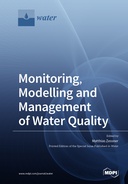Explore

Monitoring, Modelling and Management of Water Quality
0 Ungluers have
Faved this Work
Login to Fave
Different types of pressures, such as nutrients, micropollutants, microbes, nanoparticles, microplastics, or antibiotic-resistant genes, endanger the quality of water bodies. Evidence-based pollution control needs to be built on the three basic elements of water governance: Monitoring, modeling, and management. Monitoring sets the empirical basis by providing space- and time-dependent information on substance concentrations and loads, as well as driving boundary conditions for assessing water quality trends, water quality statuses, and providing necessary information for the calibration and validation of models. Modeling needs proper system understanding and helps to derive information for times and locations where no monitoring is done or possible. Possible applications are risk assessments for exceedance of quality standards, assessment of regionalized relevance of sources and pathways of pollution, effectiveness of measures, bundles of measures or policies, and assessment of future developments as scenarios or forecasts. Management relies on this information and translates it in a socioeconomic context into specific plans for implementation. Evaluation of success of management plans again includes well-defined monitoring strategies. This book provides an important overview in this context.
This book is included in DOAB.
Why read this book? Have your say.
You must be logged in to comment.
Rights Information
Are you the author or publisher of this work? If so, you can claim it as yours by registering as an Unglue.it rights holder.Downloads
This work has been downloaded 206 times via unglue.it ebook links.
- 206 - pdf (CC BY) at Unglue.it.
Keywords
- ACOLITE
- analysis method
- ArcGIS
- bayesian statistics
- chromaticity measurement
- concentration duration frequency curve
- concentration of dissolved matter
- constructed wetland
- Copernicus Programme
- CSO
- Cyanobacteria
- derivative absorbance
- diffuse nutrient emission
- diffuse pollution
- digital elevation model
- distributed modelling
- dynamic power management
- Economics
- Economics, finance, business & management
- effectiveness of measures
- empirical modeling
- ensemble learning
- Environmental economics
- Environmental science, engineering & technology
- Eutrophication
- field mapping
- flooding
- inundation mapping
- land cover
- Microcystis aeruginosa
- model evaluation
- modeling
- MONERIS
- Monitoring
- Nitrogen
- nutrient retention
- observational process ontology
- PhosFate
- phosphorus
- pollution control
- quasi-real time monitoring
- Reference, information & interdisciplinary subjects
- Research & information: general
- river basin management plan of Hungary
- scenarios and forecasts
- sediment
- semantic discovery
- sewer system
- socioeconomic context
- sources and pathways
- sources and pathways of water pollution
- Spain
- spectrophotometry
- storm drains
- surface fitting
- suspended matter
- system understanding
- Technology, engineering, agriculture
- thema EDItEUR::G Reference, Information and Interdisciplinary subjects::GP Research and information: general
- thema EDItEUR::K Economics, Finance, Business and Management::KC Economics::KCV Economics of specific sectors::KCVG Environmental economics
- trace pollutants
- unmanned surface vehicle
- urban drainage
- urban river
- Urban runoff
- Water
- Water Governance
- water monitoring
- water pollution alert
- water pollution control
- Water quality
- water quality monitoring
- water quality status
- water quality statuses and trends
- water resources management
Links
DOI: 10.3390/books978-3-0365-1547-2Editions

